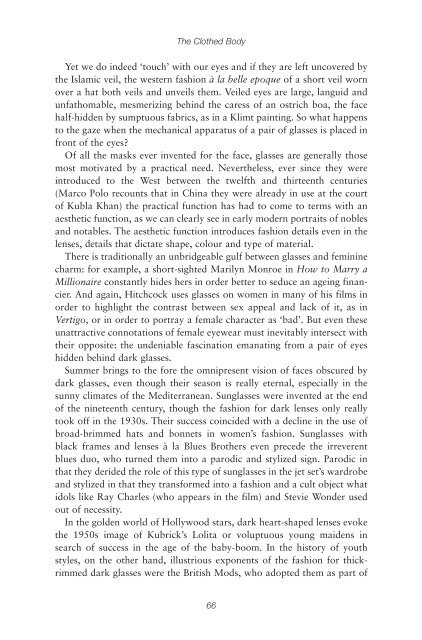You also want an ePaper? Increase the reach of your titles
YUMPU automatically turns print PDFs into web optimized ePapers that Google loves.
<strong>The</strong> <strong>Clothed</strong> <strong>Body</strong><br />
Yet we do indeed ‘touch’ with our eyes and if they are left uncovered by<br />
the Islamic veil, the western fashion à la belle epoque of a short veil worn<br />
over a hat both veils and unveils them. Veiled eyes are large, languid and<br />
unfathomable, mesmerizing behind the caress of an ostrich boa, the face<br />
half-hidden by sumptuous fabrics, as in a Klimt painting. So what happens<br />
to the gaze when the mechanical apparatus of a pair of glasses is placed in<br />
front of the eyes?<br />
Of all the masks ever invented for the face, glasses are generally those<br />
most motivated by a practical need. Nevertheless, ever since they were<br />
introduced to the West between the twelfth and thirteenth centuries<br />
(Marco Polo recounts that in China they were already in use at the court<br />
of Kubla Khan) the practical function has had to come to terms with an<br />
aesthetic function, as we can clearly see in early modern portraits of nobles<br />
and notables. <strong>The</strong> aesthetic function introduces fashion details even in the<br />
lenses, details that dictate shape, colour and type of material.<br />
<strong>The</strong>re is traditionally an unbridgeable gulf between glasses and feminine<br />
charm: for example, a short-sighted Marilyn Monroe in How to Marry a<br />
Millionaire constantly hides hers in order better to seduce an ageing financier.<br />
And again, Hitchcock uses glasses on women in many of his films in<br />
order to highlight the contrast between sex appeal and lack of it, as in<br />
Vertigo, or in order to portray a female character as ‘bad’. But even these<br />
unattractive connotations of female eyewear must inevitably intersect with<br />
their opposite: the undeniable fascination emanating from a pair of eyes<br />
hidden behind dark glasses.<br />
Summer brings to the fore the omnipresent vision of faces obscured by<br />
dark glasses, even though their season is really eternal, especially in the<br />
sunny climates of the Mediterranean. Sunglasses were invented at the end<br />
of the nineteenth century, though the fashion for dark lenses only really<br />
took off in the 1930s. <strong>The</strong>ir success coincided with a decline in the use of<br />
broad-brimmed hats and bonnets in women’s fashion. Sunglasses with<br />
black frames and lenses à la Blues Brothers even precede the irreverent<br />
blues duo, who turned them into a parodic and stylized sign. Parodic in<br />
that they derided the role of this type of sunglasses in the jet set’s wardrobe<br />
and stylized in that they transformed into a fashion and a cult object what<br />
idols like Ray Charles (who appears in the film) and Stevie Wonder used<br />
out of necessity.<br />
In the golden world of Hollywood stars, dark heart-shaped lenses evoke<br />
the 1950s image of Kubrick’s Lolita or voluptuous young maidens in<br />
search of success in the age of the baby-boom. In the history of youth<br />
styles, on the other hand, illustrious exponents of the fashion for thickrimmed<br />
dark glasses were the British Mods, who adopted them as part of<br />
66

















